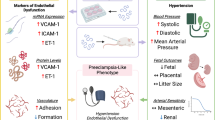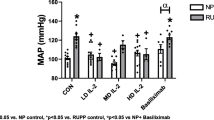Abstract
Women with hypertensive forms of pregnancy such as hemolysis–elevated liver enzymes–low platelet syndrome have increased circulating endothelin 1; however, the relationship between hypertension and endothelin 1 has not been studied. Using an animal model, we sought to determine whether there was an increased activation/dysfunction of endothelin 1, the effect of endothelin 1 receptor-A blockade on hypertension and other manifestations of hemolysis, elevated liver enzymes, and low platelets syndrome. On gestational day 12, timed-pregnant rats were infused with soluble fms-like tyrosine kinase 1 (sFlt-1) and soluble endoglin (sEndoglin; 4.7 and 7 µg/kg) via mini-osmotic pumps for 8 days. A subset of rats were treated with receptor-A antagonist (ABT-627, 5mg/kg) for 8 days. Rats with hemolysis-elevated liver enzymes-low platelet syndrome had significantly increased hypertension (P = .0001), circulating endothelin 1 (P = .03), and a significant 3.3- and 7.2-fold increase in preproendothelin messenger RNA (mRNA) expression in the placenta and liver (P = .01 and .04). Urinary protein:creatinine ratio was significantly increased in these animals (P = .0007), and circulating factors from these rats stimulated a significant increase in endothelial cell secretion of endothelin 1 (P = .001) in an in vitro assay. Blockade of the endothelin 1 receptor A significantly decreased hypertension (P = .001), circulating endothelin 1, and interleukin 17 (P = .004 and .003), placental preproendothelin mRNA expression (P = .016), and urinary protein:creatinine ratio (P = .007) in rats with hemolysis–elevated liver enzymes–low platelet syndrome. Blockade of the endothelin 1 receptor A significantly decreased hemolysis (P = .009), liver enzymes (P = .011), and significantly increased platelet levels (P = .03) and decreased circulating CD4+ and CD8+ T lymphocytes (P = .0004 and .0001) in rats infused with sFlt-1 and sEndoglin. These data support the hypothesis that endothelin 1 activation has a critical role in pathophysiology of as hemolysis–elevated liver enzymes–low platelet syndrome.
Similar content being viewed by others
References
Geary M. The HELLP syndrome. Br J Obstet Gynaecol. 1997;104(8):887–891.
Sibai B. The HELLP syndrome (hemolysis, elevated liver enzymes, and low platelets): Much ado about nothing? Am J Obstet Gynecol. 1990;162(2):311–316.
Abildgaard U, Heimdal K. Pathogenesis of the syndrome of hemolysis, elevated liver enzymes, and low platelet count (HELLP): a review. Eur J Obstet Gynecol Reprod Biol. 2013;166(2):117–123.
Wallace K, Martin J Jr, Tam Tam K, et al. Seeking the mechanisms of action for corticosteroids in HELLP syndrome: SMASH study. Am J Obstet Gynecol. 2013;208(5):380.e1–e8.
Strand S, Strand D, Seufert R, et al. Placenta-derived CD95 Ligand causes liver damage in hemolysis, elevated liver enzymes, and low platelet count syndrome. Gastroenterology. 2004;126(3):849–858.
Bussen S, Sutterlin M, Steck T. Plasma endothelin and big endothelin levels in women with severe preeclampsia or HELLP-syndrome. Arch Gynecol Obstet. 1999;262(3–4):113–119.
Tranquilli A, Landi B, Corradetti A, et al. Inflammatory cytokines patterns in the placenta of pregnancies complicated by HELLP (hemolysis, elevated liver enzyme, and low platelet) syndrome. Cytokine. 2007;40(2):82–88.
Lamarca B. Endothelial dysfunction. An important mediator in the pathophysiology of hypertension during pre-eclampsia. Minerva Ginecol. 2012;64(4):309–320.
Cai H, Griendling K, Harrison D. The vascular NAD(P)H oxidases as therapeutic targets in cardiovascular diseases. Trends Pharmacol Sci. 2003;24(9):471–478.
Wallace K, Novotny S, Heath J, et al. Hypertension in response to CD4+ T cells from reduced uterine perfusion pregnant rats is associated with activation of the endothelin-1 system. Am J Physiol Regul Integr Comp Physiol. 2012;303(2):R144–R149.
Aggarwal P, Chandel N, Jain V, Jha V. The relationship between circulating endothelin-1, soluble fms-like tyrosine kinase-1 and soluble endoglin in preeclampsia. J Hum Hypertens. 2012;26(4):236–241.
Granger J, Abram S, Stec D, Chandler D, LaMarca B. Endothelin, the kidney and hypertension. Curr Hypertens Rep. 2006;8(4):298–303.
Lerman A, Kubo S, Tschumperlin L, Burnett JJ. Plasma endothelin concentrations in humans with end-stage heart failure and after heart-transplantation. J Am Coll Cardiol. 1992;20(4):849–853.
LaMarca B. The role of immune activation in contributing to vascular dysfunction and the pathophysiology of hypertension during preeclampsia. Minerva Ginecol. 2010;62(2):105–120.
LaMarca B. Progress toward identifying potential markers for preeclampsia: a role of agonistic autoantibody to the angiotensin II type I receptor. Hypertension. 2010;55(2):236–237.
Lamarca B, Cornelius D, Wallace K. Elucidating immune mechanisms causing hypertension during pregnancy. Physiology. 2013;28(4):225–233.
Li J, Lamarca B, Reckelhoff J. A model of preeclampsia in rats: the reduced uterine perfusion pressure (RUPP) model. Am J Physiol Heart Circ Physiol. 2012;303(1):H1–H8.
Tam Tam K, Lamarca B, Arany M, et al. Role of reactive oxygen species during hypertension in response to chronic antiangiogenic factor (sFlt-1) excess in pregnant rats. Am J Hypertens. 2011;24(1):110–113.
Benyo D, Smarason A, Redman C, Sims C, Conrad K. Expression of inflammatory cytokines in placentas from women with preeclampsia. J Clin Endocrinol Metab. 2001;86(6):2502–2512.
Kupferminc M, Peaceman A, Wigton T, Rehnberg K, Socol M. Tumor necrosis factor-alpha is elevated in plasma and amniotic fluid of patients with severe preeclampsia. Am J Obstet Gynecol. 1994;170(6):1752–1757.
Wallace K, Morris R, Kyle P, et al. Hypertension, inflammation and T lymphocytes are increased in a rat model of HELLP syndrome. Hypertens Pregnancy. 2014;33(1):41–54.
Venkatesha S, Toporsian M, Lam C, et al. Soluble endoglin contributes to the pathogenesis of preeclampsia. Nat Med. 2006;12(6):642–649.
Maynard S, Min J, Merchan J, et al. Excess placental soluble fmslike tyrosine kinase 1 (sFlt1) may contribute to endothelial dysfunction, hypertension, and proteinuria in preeclampsia. J Clin Invest. 2003;111(5):649–658.
LaMarca B, Cockrell K, Sullivan E, Bennett W, Granger J. Role of endothelin in mediating tumor necrosis factor-induced hypertension in pregnant rats. Hypertension. 2005;46(1):82–86.
Amaral L, Kiprono L, Cornelius D, et al. Progesterone supplementation attenuates hypertension and the autoantibody to the angiotensin II type 1 receptor in response to elevated interleukin-6 during pregnancy. Am J Obstet Gynecol. 2014;211(2):158.e1–e6.
Wallace K, Cornelius D, Scott J, et al. CD4+ T cells are important mediators of oxidative stress that cause hypertension in response to placental ischemia. Hypertension. 2014;64(5):1151–1158.
Wallace K, Richards S, Dhillion P, et al. CD4+ T Helper cells stimulated in response to placental ischemia mediate hypertension during pregnancy. Hypertension. 2011;57(5):949–955.
Wallace K, Chatman K, Porter J, et al. Endothelin-1 is elevated in plasma and explants from patients suffering with uterine leiomyomas. Reprod Sci. 2014;21(9):1196–1205.
Novotny S, Wallace K, Herse F, et al. CD4+ T cells play a critical role in mediating hypertension in response to placental ischemia. J Hypertens. 2013;2:1–6.
George E, Cockrell K, Adair T, Granger J. Regulation of sFlt-1 and VEGF secretion by adenosine under hypoxic conditions in rat placental villous explants. Am J Physiol Regul Integr Comp Physiol. 2010;299(6):R1629–R1633.
Roberts J, Edep M, Goldfien A, Taylor R. Sera from preeclamptic women specifically activate human umblical vein enodothelial cells in vitro: morphological and biochemical evidence. Am J Reprod Immunol. 1992;27(3–4):101–108.
Roberts L, LaMarca B, Fournier L, Bain J, Cockrell K, Granger J. Enhanced endothelin synthesis by endothelial cells exposed to sera from pregnant rats with decreased uterine perfusion. Hypertension. 2006;47(3):615–618.
Pollock D, Opgenorth T. ETA receptor mediated responses to ET-1 in the rat kidney. Br J Pharmacol. 1994;111(3):729–732.
Parrish M, Murphy S, Rutland S, et al. The effect of immune factors, tumor necrosis factor-alpha, and agonistic autoantibodies to the angiotensin II type I receptor on soluble fms-like tyrosine-1 and soluble endoglin production in response to hypertension during pregnancy. Am J Hypertens. 2010;23(8):911–916.
Tanaka K, Yoshioka K, Tatsumi K, Kimura S, Kasuya Y. Endothelin regulates function of IL-17 producing T cell subset. Life Sci. 2014;118(2):244–247.
Cornelius D, Hogg J, Scott J, et al. Administration of interleukin-17 soluble receptor C suppresses TH17 cells, oxidative stress and hypertension in response to placental ischemia during pregnancy. Hypertension. 2013;62(6):1068–1073.
Cornelius D, Wallace K, Kiprono L, Dhillion P, Moseley J, Lamarca B. Endothelin-1 is not a mechanism of IL-17 induced hypertension during pregnancy. Med J Obstet Gynecol. 2013;1(1):1–10.
Dhillion P, Wallace K, Scott J, et al. IL-17 mediated oxidative stress is an important stimulator of AT1-AA and hypertension during pregnancy. Am J Physiol Regul Integr Comp Physiol. 2012;303(4):R353–R358.
Murphy S, LaMarca B, Cockrell K, Granger J. Role of Endothelin in Mediating Soluble fms-Like Tyrosine Kinase 1 Induced Hypertension in Pregnant Rats. Hypertension. 2010;55(2):394–398.
Halim A, Kanayama N, Maehara K, Takahashi M, Terao T. HELLP syndrome-like biochemical parameters obtained with endothelin-1 injections in rabbits. Gynecol Obstet Invest. 1993;35(4):193–198.
Bahde R, Kapoor S, Viswanathan P, Spiegel H, Gupta S. Endothelin-1 receptor A blocker Darusentan decreases hepatic changes and improves liver repopulation after cell transplantation in rats. Hepatology. 2014;59(3):1107–1117.
Shchekotova A, Shchekotov V, Bulatova I, Roitman A. Diagnostic efficiency of laboratory tests determining the functional status of the endothelium in patients with chronic diffuse liver diseases. Klin Lab Diagn. 2009;(10):24–26.
Feng Z, Xu X, Wu L, Wu J, Zhu S, Zheng S. Downregulation of endothelin-1 by somatostatin improves liver function of recipients undergoing adult-to-adult living donor liver transplantation. Chin Med J. 2010;123(15):1961–1966.
Jeremy J, Shukla N, Wan S, Murphy G, Angelini G, Yim A, et al. The pathobiology of endothelin-1 in vein graft disease: Are ETA receptor antagonists the solution to prevent vein graft failure? Curr Vasc Pharmacol. 2005;3(4):315–323.
Jagroop I, Daskalopoulou S, Mikhailidis D. Endothelin-1 and human platelets. Curr Vasc Pharmacol. 2005;3(4):393–399.
Helset E, Lindal S, Olsen R, Myklebust R, Jorgensen L. Endothelin-1 causes sequential trapping of platelets and neutrophils in pulmonary microcirculation in rats. Am J Physiol. 1996;271(14 pt 1):L538–L546.
Amraoui F, Spijkers L, Hassani Lahsionoui H, et al. SFlt-1 elevates blood pressure by augmenting endothelin-1 mediated vasoconstriction in mice. PLos One. 2014;9(3):e91897.
Li F, Hagaman J, Kim H, et al. eNOS deficiency acts through endothelin to aggravate sFlt-1 induced pre-eclampsia like phenotype. J Am Soc Nephrol. 2012;23(4):652–660.
Shen F, Wei J, Snowise S, et al. Trophoblast debris extruded from preeclamptic placentae activates endothelial cells: a mechanism by which the placenta communicates with the maternal endothelium. Placenta. 2014;35(10):839–847.
Lau S, Barrett C, Guild S, Chamley L. Necrotic trophoblast decris increases blood pressure during pregnancy. J Reprod Immunol. 2013;97(2):175–182.
LaMarca B, Bennett W, Alexander B, Cockrell K, Granger J. Hypertension produced by reductions in uterine perfusion in the pregnant rat: role of tumor necrosis factor-alpha. Hypertension. 2005;46(4):1022–1025.
Sedeek M, Gilbert J, LaMarca B, et al. Role of reactive oxygen species in hypertension produced by reduced uterine perfusion in pregnant rats. Am J Hypertens. 2008;21(10):1152–1156.
Sanchez-Aranguren L, Prada C, Riano-Medina C, Lopez M. Endothelial dysfunction and preeclampsia: a role of oxidative stress. Front Physiol. 2014;5:1–11.
Author information
Authors and Affiliations
Corresponding author
Rights and permissions
About this article
Cite this article
Morris, R., Spencer, SK., Kyle, P.B. et al. Hypertension in an Animal Model of HELLP Syndrome is Associated With Activation of Endothelin 1. Reprod. Sci. 23, 42–50 (2016). https://doi.org/10.1177/1933719115592707
Published:
Issue Date:
DOI: https://doi.org/10.1177/1933719115592707




